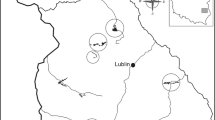Summary
Survival chances have been estimated for populations of the waterbeetle Gyrinus marinus Gyll. from capture-recapture sequences in 1974–1978. The average weekly survival chance is estimated as 0.9247 in spring, decreasing to 0.7701 in autumn; males survive longer than females. Survival shows little variation in time or space (variation coefficient V<0.1). Survival chance did not significantly decrease with age. Freshly emerged tenerals apparently have a lower survival chance than older beetles. The survival chance during hibernation (October–April) is about 0.33, with a greater variation between years (V=0.7) than between populations (V=0.4).
Similar content being viewed by others
References
Baars MA, Dijk ThS van (1984) Population dynamics of two carabid beetles at a Dutch heathland II. Egg production and survival in relation to density. J Anim Ecol 53:389–400
Bailey NTJ (1951) On estimating the size of mobile populations from recapture data. Biometrika 38:293–306
Begon M (1979) Investigation Animal Abundance capture-recapture for biologists. Edw Arnold London
Cushing DH, Jones FRH (1968) Why do fish school? Nature 218:918–920
Dijk ThS van (1983) The influence of food and temperature on the amount of reproduction in carabid beetles. Rep 4th Symp Carab'81
Eijk RH van der (1983) Population dynamics of gyrinid beetles I. Flight activity of Gyrinus marinus Gyll. Oecologia (Berlin) 57:55–64
Eijk RH van der (1986) Population dynamics of gyrinid beetles II. Reproduction and recruitment. Oecologia (Berlin) 69:31–40
Fisher RA, Ford EB (1947) The spread of a gene in natural conditions in a colony of the moth Panaxia dominula L. Heredity 1.2:143–172
Jolly GM (1965) Explicit estimates from capture-recapture data with both death and immigration-stochastic model. Biometrika 51.1 &2:225–247
Lack D (1943) The age of the blackbird. Brit Birds 36:166–175
Manly BFJ, Parr MJ (1968) A new method of estimating population size, survivorship, and birth rate from capture-recapture data. Trans Soc Br Ent 18:81–89
Meyer J (1975) Carabid Migration Studied with Laboulbeniales (Ascomycetes) as Biological Tags. Oecologia (Berl) 19:99–103
Ochs G (1969) The ecology and ethology of whirligig beetles. Arch Hydrobiol Suppl 35, 37:375–404
Sachs L (1982) Applied Statistics. A Handbook of Technics. Springer New York
Scheloske HW (1969) Beiträge zur Biologie, Ökologie und Systematik der Laboulbeniales (Ascomycetes) unter besonderer Berücksichtigung der Parasit-Wirt-Verhältnisse. Parasitolog Schr Reihe 19:176 pp
Seber GAF (1965) A note on multiple-recapture census. Biometrika 52,1 & 2:249–259
Southwood TRE (1978) Ecological methods (2nd ed). Chapman and Hall, London
Author information
Authors and Affiliations
Additional information
Communication N0 301 of the Biological Station, Wijster
Rights and permissions
About this article
Cite this article
van der Eijk, R.H. Population dynamics of gyrinid beetles. Oecologia 69, 41–46 (1986). https://doi.org/10.1007/BF00399035
Received:
Issue Date:
DOI: https://doi.org/10.1007/BF00399035




